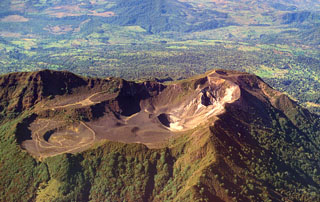Report on Turrialba (Costa Rica) — 21 September-27 September 2016
Smithsonian Institution / US Geological Survey
Weekly Volcanic Activity Report, 21 September-27 September 2016
Managing Editor: Sally Sennert.
Please cite this report as:
Global Volcanism Program, 2016. Report on Turrialba (Costa Rica) (Sennert, S, ed.). Weekly Volcanic Activity Report, 21 September-27 September 2016. Smithsonian Institution and US Geological Survey.
Turrialba
Costa Rica
10.025°N, 83.767°W; summit elev. 3340 m
All times are local (unless otherwise noted)
OVSICORI-UNA reported that during 21-22 September multiple eruptive episodes at Turrialba generated ash, gas, and steam emissions that generally rose as high as 700 m above the crater and drifted N, NW, W, and SW. Ashfall and a sulfur odor were reported in some areas of Valle Central. An energetic episode that began at 0320 on 22 September produced an ash plume that rose 2 km and drifted WSW. Another episode accompanied by tremor which began at 1345 generated an ash plume that rose 1 km. Surficial activity significantly decreased on 23 September; a few short episodes were detected but weather clouds prevented observations. Seismicity remained high, characterized by very-long-period events. Seismicity decreased on 24 September and activity was very low through the afternoon of 25 September; a few minor eruptions were detected. At 2110 on 25 September an eruption was detected seismically, but cloud cover blocked views. Ashfall and a sulfur odor was reported in Valle Central communities, including San José and Heredia. An eruption at 1225 on 26 September produced an ash plume that rose 1 km and drifted NW. Cloud cover again prevented visual observations of activity that began at 1242, and lasted for four hours. Based on the amplitude of the seismic signal, webcam images, and observations from scientists in the field, ash plumes were estimated to rise as high as 2 km. Continuous passive emissions continued to rise as high as 2 km until 1000 on 27 September; between 1000 and 1242 ash plumes rose 300-500 m.
Geological Summary. Turrialba, the easternmost of Costa Rica's Holocene volcanoes, is a large vegetated basaltic-to-dacitic stratovolcano located across a broad saddle NE of Irazú volcano overlooking the city of Cartago. The massive edifice covers an area of 500 km2. Three well-defined craters occur at the upper SW end of a broad 800 x 2200 m summit depression that is breached to the NE. Most activity originated from the summit vent complex, but two pyroclastic cones are located on the SW flank. Five major explosive eruptions have occurred during the past 3500 years. A series of explosive eruptions during the 19th century were sometimes accompanied by pyroclastic flows. Fumarolic activity continues at the central and SW summit craters.
Source: Observatorio Vulcanologico y Sismologico de Costa Rica-Universidad Nacional (OVSICORI-UNA)

